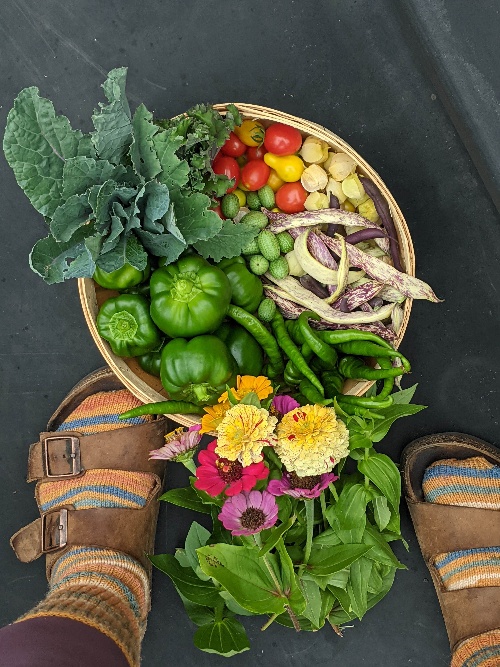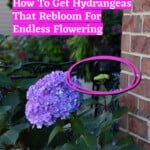
It is a truth universally acknowledged that once you learn a gardening “golden rule,” you’ll have to quickly unlearn it. Or at the very least, you might need to add some asterisks and exceptions to it.
Let me give you an example of one of the first knowledge traps that I fell into when I was a beginner gardener. When I first learned that you can deadhead perennials to encourage more blooms, I generalized that to mean all perennials.
All of them!
Everything that survived from one year to another could surely be made to rebloom in the summer if we just removed the dead flowers, right?
That’s only partially right, unfortunately.
Take hydrangeas, as an example.

Hydrangeas only bloom once a season and they’re done.
Old wood hydrangeas form their blooms the previous year and then open up their flowers early in the summer.
New wood hydrangeas bloom on current year’s growth and then flower a bit later.
How do you know which is which? Have a look at this article I wrote for a breakdown of the main hydrangea groups.
This means that hydrangeas won’t bloom again in the same growing season, and no amount of deadheading will influence that. The energy already stored in the buds is all we get.
Unless…
Is there any way to get hydrangeas to rebloom?
Yes, I found out that there is a loophole to this rule, but only if you buy and plant a remontant hydrangea.
Let me tell you a bit about what ‘remontant’ means.
Remontancy is a botanical term that refers to a plant that can bloom twice during the same growing season or the same year.
Two more common terms that we use for this plant characteristic are “reblooming” and “repeat flowering.” You may have heard this term when talking about remontant roses? But there are other shrubs that can be remontant, such as lilacs, spirea and weigela.

When it comes to hydrangeas, reblooming varieties are a relative newcomer on the market.
I watched an interesting interview with Dr. Michael Dirr about how reblooming hydrangeas were first bred.
Back in the mid-90s, the University of Georgia had been trying to breed a type of Hydrangea macrophylla that would bloom both on old wood and on new wood. It wasn’t just for the sake of aesthetics, but a sort of insurance against early fall and late spring freezes that would kill old wood buds, leaving the shrubs without any viable buds for the year.
In 1998, as the lead plantsman at the University of Georgia, Dr. Michael Dirr, was visiting Bailey Nurseries in Minnesota, he noticed that they also had a row of macrophylla with both old flowers and young flowers on it.

This was in September. So it was unusual, even to Dr. Dirr, for those hydrangeas to be in bloom that late in the year. It turns out the nursery was also trialing reblooming hydrangeas. They had stumbled upon a reblooming hydrangea in a garden in Saint Paul, Minnesota. They got permission to take cuttings, tested them, pedigreed them and then started growing them.
It took another six years from that encounter for Bailey Nurseries to release the first truly remontant commercially.
In 2004, the Endless Summer series hit the shelves and our expectations for hydrangeas shifted once again.
What type of hydrangea will rebloom?
Over the past two decades, plant breeders have been perfecting and expanding the range of remontant hydrangeas. That’s why you’ll see full series nowadays, with several cultivars in each series and new ones coming on the market regularly.
In my research, I found the newest release (called Let’s Dance ‘Lovable’) came on the market commercially as recently as 2023.

Look for the following names if you want hydrangeas that rebloom.
Endless Summer – this is the original series that has currently been expanded to six cultivars.
The Original – the direct descendant of the initial trials;
BloomStruck (sold as BloomStar in Europe) – a more heat-tolerant hydrangea in deeper shades of color; it even had colored stems, usually red or burgundy;

Twist-N-Shout – pink or blue large lacecaps;
Blushing Bride – white, pink or blue mopheads;
Summer Crush – a smaller and more compact mophead hydrangea;
Pop Star – a compact reblooming hydrangea released by Bailey Nurseries in 2023 after five years of trials. They called this “the strongest rebloomer we’ve ever trialed” because it is the quickest macrophylla to rebloom. It takes new buds only four weeks to sprout back after a cutback of the old terminal buds.

There are other series of reblooming hydrangeas, each with multiple cultivars.
Let’s Dance – a series sold by Proven Winners in several cultivars, including Blue Jangles, Rave, Arriba!, Can Do!, Rhythmic Blue, Sky View and Big Band;
Cherry-Go-Round – a compact vibrant cherry-red hydrangea suitable for containers;
Tuff Stuff – a mountain hydrangea series that includes Tiny Tuff Stuff, Tuff Stuff Ah-Ha, Tuff Stuff Top Fun and Tuff Stuff Red.

How should I prune my reblooming hydrangea?
Since this type of hydrangea is still an old wood hydrangea as its core, you should only do very light pruning in early spring. Remove the dry flower heads from last year. Cut at an angle just above the first green bud from the top.
Once the first series of blooms is starting to fade – usually around mid-July, but it could vary depending on your gardening zone – you can start deadheading the spent blooms.
It may take up to six weeks for blooms that grow on current season’s growth to appear.

So there may be a period around early August when the shrub is just foliage but no flowers. That’s absolutely normal because we’re dealing with consecutive blooming here, not concurrent blooming.
It’s important that you resist the urge to fertilize your hydrangeas now. Not only will it not help them, since these hydrangeas are already engineered to rebloom. But it may even hurt them by encouraging leaf production instead of flower production.
The good news is that this second set of flowers may last well into the fall, sometimes as late as mid-October.
Related Reading: What to do with hydrangeas after they bloom.
Where can I buy reblooming hydrangeas?
Not all nurseries will grow and sell reblooming hydrangeas. Because these are patented plants, the nurseries have to buy licenses from the original breeder that holds the copyright.
Have a look at the links below to see if these retailers ship to your area or if there are any licensed resellers in your state.
Hydrangea.com – just search for “rebloom” for a good selection;
Endless Summer Hydrangeas – the original series developed by Bailey Nurseries;
Proven Winners – they sell the Let’s Dance series;

Monrovia – check their website a list of retailers that sell the Seaside Serenade series;
Great Garden Plants – the sell the Tuff Stuff mountain hydrangea;
Bloomin’ Easy Plants (Canada)
Plant Central (Canada)
I’ll break it to you right now, just so that you don’t get sticker shock. Reblooming hydrangeas are generally more expensive than regular hydrangeas.

And lest you think you’ve been duped about the reblooming characteristic, consider that it might take up to three years for a hydrangea shrub to get established and reach its full blooming potential.
So we should ideally think of hydrangeas as a long-term investment that will pay full benefits in a few years from when we plant them.

Get the famous Rural Sprout newsletter delivered to your inbox.
Including Sunday musings from our editor, Tracey, as well as “What’s Up Wednesday” our roundup of what’s in season and new article updates and alerts.


